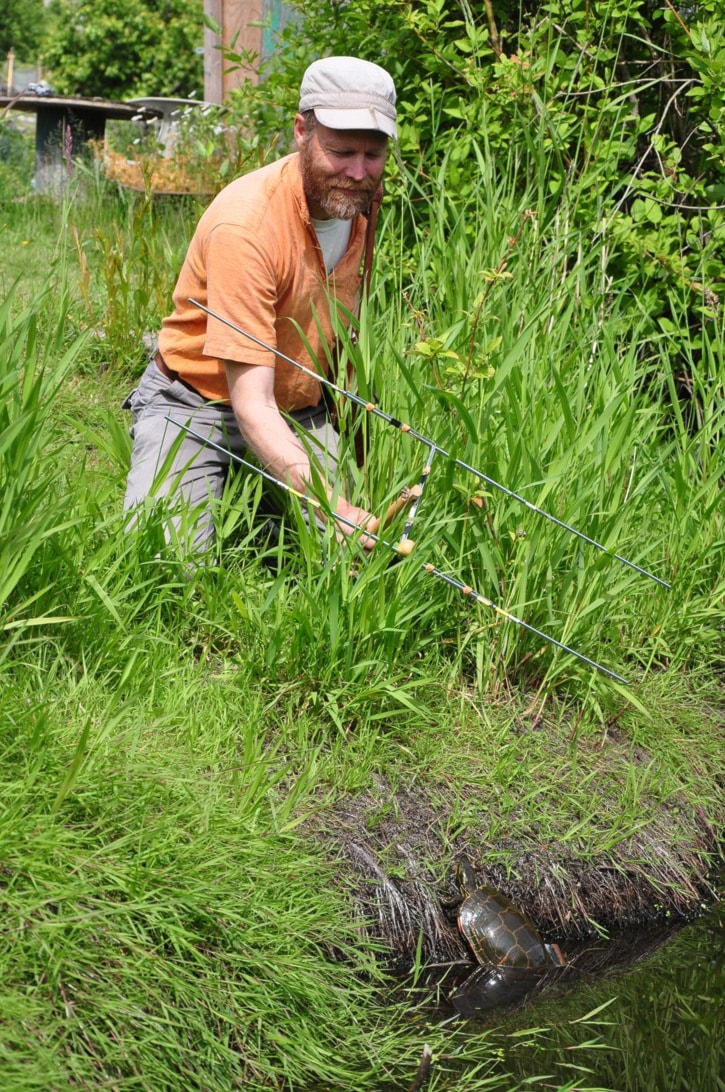With an H-shaped antenna held aloft over his head, Christian Engelstoft strides quickly between garden rows, following a telltale electronic chirp. Somewhere nearby there is a Western painted turtle.
This is no ordinary turtle. The old matriarch did what most people wouldn’t dare – it boldly crossed the Pat Bay Highway, from Swan Lake to the Capital City Allotment Gardens. Engelstoft knows this due to the transmitter attached to her shell.
The turtle is one of four radio-tagged at Swan Lake for an ongoing study that ultimately aims to help preserve the Western painted turtle, a native to Vancouver Island but deemed a species at risk.
“We track them regularly at the lake. We know where they hibernate, where they go, how they use the lake during the summer and fall,” says Engelstoft, a wildlife biologist working with the Habitat Acquisition Trust and the federal Habitat Stewardship Program.
“This year one decided to cross the highway to lay eggs in the Allotment Gardens. One of our objectives was to see if they would cross the highway. Now we know for sure they do.”
After a few minutes of bushwhacking along Swan creek, which cuts through the community garden land, the transmitter signal allows us to zero in on her location. Soon the lunch-plate sized female emerges from the water and crawls up the creek bank to bask in the sun, with the thumb-sized transmitter and long antenna clearly visible on her shell.
The turtle is old, perhaps a couple decades or more due to its size, although its impossible to be precise just from sight. About two weeks ago, its miraculous journey likely took it either under the highway through a long culvert, or over the top, where it braved the roadway. Given that the highway isn’t littered with turtle carcasses, such migrations are considered rare.
“Turtles don’t like long dark tunnels. It’s more likely it went over the top,” Engelstoft says. “It’s a busy four-lane road. Not a good place to cross.”
But with rich soft soils, the community gardens are an attractive place for turtles to lay eggs, although fraught with risk due to unwitting gardeners digging and planting veggies.
Adult females like this one are important for the species’ overall population dynamics. Due to lengthy breeding cycles and low survival rates, biologists calculate that if 50 females are killed in three years, the population will be extinct in 50 years.
“It takes a long time for them to reproduce at a successful rate,” Engelstoft says.
With limited wetland habitat in Greater Victoria and a major highway next to Swan Lake, Engelstoft admits boosting Western painted turtle numbers will be a tough, long-term effort. He suggested barriers might be needed to keep turtles off the highway and perhaps a nesting bed at the Allotment Gardens for breeding.
“The turtle population in Swan Lake isn’t particularly big, about 20 animals,” he said. “Most are known to us. There’s probably no more than 25 in Swan Lake, but that’s just a guess.”
Todd Carnahan, the land-care co-ordinator with HAT, is working with Capital Region homeowners to keep an eye out for Western painted turtles, among other at-risk species, such as the blue-gray taildropper slug and the sharp-tailed snake.
Reports from homeowners and citizens are the best way for researchers to get an estimate of where turtles are migrating and nesting, he said.
“The best way the public can help is to call or email that they’ve seen a turtle," he said. "Getting public reports is better that sticking telemetry devices on turtles.
“Ultimately it will pay off for the entire population.”
To report a turtle sighting, email Carnahan at todd@hat.bc.ca or call 250-995-2428. See hat.bc.ca for more.
editor@goldstreamgazette.com.
